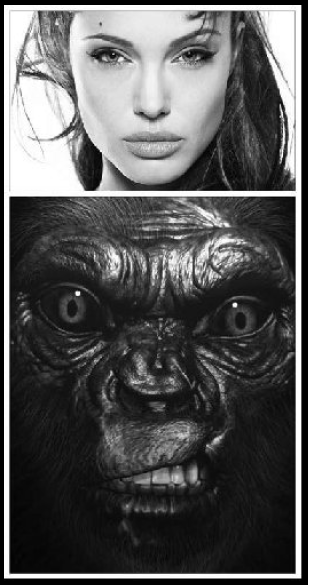
Nymph of yore.

Nymph of today.
I recently mentioned the film The Village, and yesterday I watched the most exquisite scenes.
What impressed me most were the shots of the lead actress, and how she acted, perfectly imitating 19th-century mannerisms: how American women used to behave. I kept telling myself, awestruck, that this woman was absolutely beautiful, and I imagined what it would be like to marry such a creature and constantly gaze upon her! The story is simply a fairy tale, but what’s worthwhile is that only white people appear in the film, and the director’s artistic virtuosity is evident in quite a few shots.
In the end, I was surprised that the director—an Indian man!—was also the producer and writer of that 2004 film. It’s true that one of my two favourite films for the sacred words, P&P (2005) and S&S (1995), both based on Jane Austen novels, was also filmed in this century. But both were filmed in England. As for LOTR, it was filmed in New Zealand.
Aside from The Village, written, produced, and directed by an Indian man, is there an American film from this century that stars a young woman whose mannerisms overwhelmingly inspire a man to marry someone like her, but filmed by a white man? It’s not about beautiful women appearing on the big screen. It’s about any movie inspiring a white man to marry someone like that heavenly creature.
Does such 21st century American film exist…?
(secondary slogan)
“…because the beauty of the White Aryan woman shall not perish from the Earth.”

Catalina, the crown of the
evolution, a girl I met in 1980.
Drying the books that got wet gave me the opportunity to reread some pages of those I had read long ago. In the series “Sixteen Years Later” I talked about the texts in a binder I read when, starting in August 2009, I discovered a healthy white nationalism that hadn’t yet suffered the regression of today. Now I would like to discuss one of the books I read before my racial awakening.
As an anecdote, the books that were most damaged were the science-fiction paperbacks I bought in the 1980s and 90s. Since the task of drying them is enormous, and it is difficult for me because the sun rarely shines during this rainy season, and above all, I must prevent the proliferation of mould on the pages that had become soaked, I decided to tear out the wet pages that didn’t have my footnotes. It is not difficult to acquire other copies of the books I have mutilated. What is irreplaceable are my footnotes. So, in my paperback copy of Isaac Asimov’s Foundation, which I read in 1994, I tore out almost all the pages to save myself the painful task of drying them.
Ever since I read it, Asimov’s science fiction has bothered me greatly. In another of my Asimov books, a non-fiction one, this Jew confesses that he loved living in New York. The room where this monk of letters wrote didn’t even have a window!
The difference between Aryans and Jews is that Aryans, being much more physically beautiful (see what I said about Éowyn in my post yesterday), have a religious calling to beauty that Jews lack (unless they have mixed genetically with Aryans, like Felix Mendelssohn). If we compare Asimov’s most renowned science-fiction work, Foundation, with Arthur Clarke’s The Songs of Distant Earth, the latter’s futurism even reminded me of Parrish’s paintings. The Jew lacks that call to beauty, at least to the religious level that I feel (cf. David Lane’s 14 words referring to the Aryan woman).
 What bothered me about the first book in the Foundation series I read is that Asimov simply transfers his beloved New York to the capital of the empire, Trantor, with 40 billion humans: the centre of all intrigue and symbol of imperial corruption. Every day, fleets of tens of thousands of ships brought the produce of twenty agricultural worlds to the tables of Trantor. It’s a shame that Aryans like George Lucas have imitated Trantor with the city of Coruscant. Like Trantor, Coruscant is a kind of super-developed New York that encompasses the entire planet (in Lucas’ universe, Coruscant is also the seat of government). All of this is degeneration, obviously, and you have to read about what Thalassa was like in The Songs of Distant Earth to understand it.
What bothered me about the first book in the Foundation series I read is that Asimov simply transfers his beloved New York to the capital of the empire, Trantor, with 40 billion humans: the centre of all intrigue and symbol of imperial corruption. Every day, fleets of tens of thousands of ships brought the produce of twenty agricultural worlds to the tables of Trantor. It’s a shame that Aryans like George Lucas have imitated Trantor with the city of Coruscant. Like Trantor, Coruscant is a kind of super-developed New York that encompasses the entire planet (in Lucas’ universe, Coruscant is also the seat of government). All of this is degeneration, obviously, and you have to read about what Thalassa was like in The Songs of Distant Earth to understand it.
In Foundation 25 million planets were inhabited in the Galaxy but the people that the novelist imagined were, from my POV, as Neanderthaloid as humans today. We can already imagine the sidereal level of unnecessary suffering that would exist in such a galactic nightmare!
But Asimov doesn’t see any of this. The city he imagines, covering the entire planet, lives under metal. People no longer saw the sky or the heavens. Not even the inhabitants knew what season it was outside the metal skin of the world—except for the emperor’s palace, nestled in natural land, full of green trees and adorned with flowers: a small island in an ocean of steel.
I have said it before, and it is worth repeating: the stars are not for man. Hitler himself believed that overmanhood could only arise on Earth. Even some YouTubers who speculate on cosmology are beginning to realise this; for example, what this guy says at the end of his video (yesterday I listened to that video in full, although without seeing the offensive images).
Even that vlogger fails because he succumbs to the YouTubers’ trend of saturating his videos with images of extra-terrestrial and space recreations and the like. Being faithful to Earth means attachment to earthly beings and landscapes; for example, the canvases of Romantic painters (Hitler tried, unsuccessfully, to be one of them). And knowing oneself. Only then can one know the universe and the Gods.
A scene like the one I embedded yesterday about Edoras tells me more than any of the hundreds of books Asimov wrote.
extermination, 4
Editor’s Note: Not since I read Desmond Morris’s The Naked Ape decades ago have I been so fascinated by facts about our prehistory that I knew nothing about, in part because academia has been under the control of an anti-white, neochristian mentality that considers these topics taboo, including Aryan beauty. As for Danny Vendramini’s book, below I have omitted the numbers referring to the bibliographical notes:
______ 卐 ______
Nobody would want a mate who looked like a Neanderthal, so the new ‘human look’ became increasingly subject to sexual selection. As the ‘new look’ became de rigueur, the old look became subject to artificial selection. Not having ‘the look’ was not only seriously ‘uncool’—it was likely to get you killed.
The characteristics which came under the most intense meta-selectional pressure were physical features that could be seen from a distance, because early identification of a predator is at the core of survival. This would mean that, for humans, body hair (length, density and colour) gait, posture, body silhouette and facial features were the most obvious foci of predator identification and differentiation.
A hairy problem
Although it is interesting to speculate on what colour skin the Skhul-Qafzeh people had, it was not a factor at the time because it is almost certain that the Skhul-Qafzeh people were covered in dense body hair.
While readers may find the prospect of recent human ancestors sporting so much body hair unpalatable, this is precisely what NeoDarwinian theory predicts. Coming from Africa where they occupied an open savannah environment, it is highly likely that the Skhul-Qafzeh people acquired a coat of protective hair to insulate them from the hot African sun and its equally cold nights. The same reasoning suggests that—like lions, monkeys and other mammals occupying the same grassland environments—lightbrown fur would probably have been most adaptive because it facilitated concealment from predators. So, what happened to the hair? Can NP theory shed any new light on this age-old question?
The loss of body hair in humans—but in no other primate—has generated a vigorous debate among anthropologists for decades. It’s particularly puzzling in light of the fact that hairlessness is maladaptive in terms of climate extremes, heat stress, sunburn, skin cancers, hypothermia and low ambient temperature environments. [Author’s Nota benne about human hairlessness:] (Actually, modern humans are not hairless. But discarding our thick, long and highly pigmented hair (called terminal hair) in favour of fine, short and unpigmented vellus hair has created the impression of hairlessness. For the purposes of this book, terms like hairlessness and denudation are used even though they’re not strictly correct.)
In Before the Dawn, Nicholas Wade outlines the paradox:
Hairiness is the default state of all mammals, and the handful of species that have lost their hair have done so for a variety of compelling reasons, such as living in water, as do hippopotamuses, whales and walruses, or residing in hot underground tunnels, as does the naked mole rat.
Innumerable theorists have attempted to explain why only humans turned into a ‘naked ape’, including Charles Darwin who argues:
No one supposes that the nakedness of the skin is any direct advantage to man; his body therefore cannot have been divested of hair through natural selection. […] in all parts of the world women are less hairy than men. Therefore we may reasonably suspect that this character has been gained through sexual selection.
A variation of Darwin’s sexual selection theory has been proposed by American psychologist Judith Rich Harris. She believes that hairlessness and pale skin are the result of sexual selection for beauty, which operates through a form of infanticide she calls parental selection. Harris argues that historically, parents frequently killed infants they didn’t consider beautiful enough, and one of the criteria for beauty she nominates is hairlessness. […]
Negative attitudes to hirsutism and a preference for hairlessness (personally and in prospective mates) are universal across human cultures throughout recorded time. Because artificial selection was practised almost exclusively by males, the selection pressure for female denudation would have been even more acute, resulting in women becoming even less hairy than men. This indicates that the pressure on women and girls to be hairless is anchored in the threat of lethal force wielded exclusively by men since the Late Pleistocene.
While hairy aggressive men were quite prepared to kill hairy women, they were less enthusiastic about topping themselves. This reasoning is supported by considerable sociological research which shows modern women and girls traditionally come under greater pressure to be less hairy than men. For example, a study of 678 UK women in 2005 found that 99.71 percent of participants reported removing body hair. Citing examples of depilation in ancient cultures (Egypt, Greece and Rome) and in a variety of modern societies (Uganda, South American and Turkey), cultural anthropologist Wendy Cooper contends that the need for women to remove body hair is deeply embedded in human nature.

Philosophers and scientists have pondered the aesthetics of human beauty for thousands of years but are still no closer to explaining them, or why our faces look so different from those of every other primate. Finally, we have a simple answer—the human face evolved to be visually different from Neanderthals—allowing us to tell friend from fiend. Today, Neanderthal facial characteristics (as depicted in the forensic reconstruction) provide an innate standard by which humans judge ugliness and beauty. The less like this Neanderthal you look, the more ‘beautiful’ you are.
____________
N.B. You can read the first 35 pages of Vendramini’s book here.
In my post yesterday, I wrote:
Psychiatry is just the tip of the iceberg. The whole problem has to do with a society that wants to know nothing about existential problems.
This includes the racial right and explains why my posts on the subject don’t get comments, leaving Ben and me talking to ourselves.
But almost everyone knows that it is a calamity to live with a loved one who suffers from a severe mental disorder. Why not try to grasp the new paradigm for understanding disorders? (Well, not so new: some honest mental health professionals have been saying since the 1940s that abusive parents were involved in their children’s disorders.) The fact is that without properly understanding mental disorders, it is impossible to do anything substantial to save either our disordered loved ones, or the madmen who are ethnically self-destroying in the West.
The case of Benjamin, whom I will continue to quote, illustrates the new paradigm. The antidepressants he religiously took were of no use to him because those pills never addressed the root cause of his self-harming behaviour. In my Day of Wrath (DOW) I mention that pre-Hispanic Amerindians practised self-harm, and even Emperor Moctezuma had to ritually self-harm (drawing blood from his ear, for example). The Mayans did it too, even the kings. Given that in Mesoamerican culture self-harm was not only accepted but promoted—in Tenochtitlan children had to self-harm at the elite school, the Calmécac—it should be obvious that the subject needs to be investigated.
I iterate: it is impossible to save the Aryan if psychoses are not fully understood. Yesterday, for example, I watched Disney’s Sleeping Beauty for the umpteenth time. Those were times when Aryans still knew, like Prince Philip, that we must fight for the maiden we met in the forest, “gold of sunshine in her hair; lips that shame the red, red rose…”
What is worth remembering about those healthier times in which the film was released is that Aryan beauty—the 14 words!—was still valued to the extent that its preservation was sought.
My claim is that, although it is universal and not individual, the psychosis that currently covers the West—rampant feminism is nothing more than ethnic suicide for those who practise it—can only be understood through a psychohistorical variant of the trauma model of mental disorders. The Amish don’t suffer from this psychosis, and a female friend of my sister’s, educated in the old-fashioned way (remember what I said in my post yesterday about a very traditionalist priest I met) had nine children in Monterrey.
It is of no use for our goal if I focus exclusively on Mein Kampf today when the white race is suffering from a folie en masse that is annihilating it. The cause of mental disorders should be investigated, far from the medical models that only serve to enrich Big Pharma. Anyone who assimilates the content of DOW—and even better, its more detailed expansion in my trilogy—will understand not only the self-harming Aztecs but also the individual disorders that contemporary Aryans suffer from, such as so-called schizophrenia and others.
Lebenskraft ! (4)
Bratislava
27th April
En route to Budapest I made a stop to visit the beautiful capital of Slovakia, a city bathed by the Danube, to explore its small streets.
But it is the beauty of the Aryan race that moves me to blog. In the studio where I work you can see some framed pictures I took from Parrish’s poster book (here and here), where we see perfect nymphs. In Parrish’s book we can also see ephebes, like these in the first illustration of the book, although I didn’t frame that image.
In Bratislava I made a disturbing find.
Since only the most beautiful specimens of the Aryan race are my inspiration, I couldn’t fight for the whites I saw in the Slovak Republic capital. I even saw a short woman walking next to a black man. Unlike the nymph I saw in Prague who was kissed by a gook, a female specimen who might as well have modelled for Parrish, the spectacle of the short woman in Bratislava didn’t bother me at all: her face was ugly, like most of the whites I saw there.
Another thing that surprised me was that the white men in Bratislava were shorter in stature than I was. In my soliloquies I re-evaluated the years I spent in the UK and the US, where I got to see women as beautiful as the paintings that now adorn the walls of my studio.
In my notebook I wrote: ‘For this race I wouldn’t fight, only for the perfect nymphs I have seen in regions much less mixed with non-Aryans. What a gulf with Catalina and Carmen!’[1] And I thought of the Norwegian actress Marta Kristen from Lost in Space, who had been born in one of Himmler’s human farms to breed a perfect race. I also wrote in the notebook I had bought in Prague: ‘These are the kind of purebred creatures who should now be living in all the parts of Europe I have visited, instead of these third-rate Europeans who evoke spaghetti Westerns’. And added: ‘I greatly despise white nationalists because, given their Christian/neochristian programming—egalitarianism among whites—they are incapable of making these distinctions. Himmler wasn’t of this perfect prototype, but he was noble enough to recognise it and to seek out, among the Nordics, the prototype’.

Then I sat down on a street famous for its trees to look at the faces of the people passing by. After a while I realised that I was next to the American embassy!
______________
[1] I talk about Catalina and Carmen in Lágrimas, the third book of my autobiography.
 A brief word about Pyotr Ilyich Tchaikovsky.
A brief word about Pyotr Ilyich Tchaikovsky.
In the comments section, the day before yesterday I spoke of the need to ban all kinds of dances in vogue in the Gomorrah world, even if they are heterosexual Gomorrahites: dances that involve such degenerate music that they make one want to flee the West as much as Lot fled from Gomorrah.
To understand a contemporary Lot it is necessary to be musically educated from early childhood. Since I was a very small child my father, a composer, put on the record player so I could listen to works by Mussorgsky and Stravinsky. So Russian orchestral music was my first love. Already at the age of six, I went with my mother to see Sleeping Beauty on the big screen, whose musical score, in which Walt Disney used Tchaikovsky, is magnificent. Thus I would like to say a few words about this composer.
What is most striking is that in 1854 his mother died during a cholera epidemic: a brutal blow when Tchaikovsky was fourteen years old. Almost forty years later, it is rumoured, Tchaikovsky drank water during another cholera epidemic without boiling it, knowing it was forbidden. How he was treated as a child we will not know, although I would like to know if any biographies speak of what his early years at home were like. All I know is that, according to a booklet by Javier Alfaya, Tchaikovsky ‘always kept open the wounds of his childhood and adolescence’. The fact that his brother Modest also became a homosexual makes me suspect some toxic atmosphere in the family dynamics of his childhood and adolescence.
But the current era that inverts values to the extent of glorifying Gomorrah, when speaking of Tchaikovsky omits extremely important data, such as the fact that in 1867 he fell in love with a woman, the singer Désirée Artôt, whom he wanted to marry. This fact belies the fashion of calling Tchaikovsky ‘homosexual’ in this era of glorification of inverts. Considering this simple fact he was bisexual.
True, Tchaikovsky didn’t understand the music of Wagner, who was my favourite composer even when I was an anti-Nazi normie. But he loved Italy and especially Florence, which I have visited. I like that Tchaikovsky rejected Brahms’ music: ‘His music doesn´t burn with the fire of genuine feeling, it lacks poetry’ and is ‘just empty space’. And I am also pleased that he despaired of Beethoven’s quartets (well into the 1970s I made an enormous effort to understand them but even now I find them very depressing). Of Bach, Tchaikovsky simply said that he was interested in him but didn’t consider him a great genius; once again, just what I feel.
I don’t want to say much in a very brief note except to add that my favourites of Tchaikovsky’s are the Nutcracker Suite, the Fourth Symphony and the first movement of his Piano Concerto No. 1.